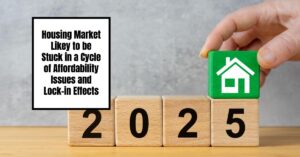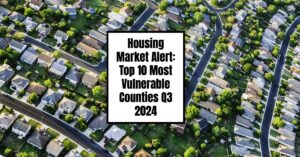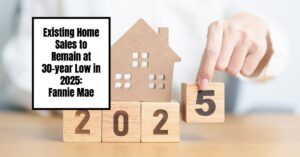As we look toward the future of the housing market, one fact stands out: the housing market is unlikely to thaw in 2025 due to affordability challenges and the persistent “lock-in effect.” In a recent December 2024 commentary by the Fannie Mae Economic and Strategic Research (ESR) Group, it was made clear that the ongoing challenges faced by potential homebuyers will continue to suppress housing activity. With existing home sales hovering near multi-decade lows and affordability remaining a key issue, many are left wondering what the future holds.
Housing Market Forecast 2025: ‘Lock-in Effect' and Affordability Key Factors
Key Takeaways
- Affordability Challenges: Continuous high mortgage rates and elevated home prices are outpacing wage growth.
- Lock-in Effect: Current homeowners with low mortgage rates are reluctant to sell, limiting inventory.
- Sales Predictions: Existing home sales are expected to remain stagnant, with slight increases projected.
- Regional Variations: Different areas will experience varying levels of market activity, particularly favored are regions like the Sun Belt.
- Future Outlook: While the overall market appears sluggish, some segments may show resilience, particularly in new home sales.
Understanding the Current Housing Market Climate
The U.S. housing market has been rocked by various challenges over the past few years, many of which are projected to continue well into 2025. Affordable housing is becoming a significant concern as potential buyers grapple with the reality of rising home prices and high mortgage rates that have lingered around 6%.
According to Fannie Mae, this trend is not just temporary; it represents a deeper systematic issue within the market. Homebuyers are increasingly pressured by the dual threats of high prices and interest rates, which are likely to stay elevated, significantly dampening the overall demand for homes (Fannie Mae Commentary, December 2024).
Among the most pressing challenges is the phenomenon known as the “lock-in effect.” Essentially, this term describes the reluctance of current homeowners to sell their homes and give up their low mortgage rates for higher ones currently in the market. This voluntary stasis means fewer available homes for potential buyers, creating an ongoing imbalance between supply and demand, which pushes prices higher (New York Times, 2023).
Affordability: A Lingering Crisis in Housing
One of the major takeaways from the Fannie Mae report is the persistent challenge of affordability. Even though nominal wage growth is expected to slowly start to outpace home price increases for the first time in over a decade, this will likely not be enough to overhaul the situation. According to Fannie Mae's chief economist, Mark Palim, buyers face an uphill battle as prices remain constrained (Fannie Mae Research and Insights).
The locked-in homeowners are experiencing a drastic divide between their favorable mortgage rates and the rising costs that new buyers face. This disparity deters many potential sellers from entering the market and exacerbates the already strained availability of homes. The report states, “From an affordability perspective, we think 2025 will look a lot like 2024,” indicating that little change is expected on the horizon (Fannie Mae Commentary, December 2024).
Economic Outlook for 2025: A Cautiously Optimistic Perspective
Despite these challenges, there is a sense of cautious optimism regarding the broader economic landscape. The economy is forecasted to expand at a pace above historical trends, which could lead to some relief in housing challenges. Still, fundamental issues surrounding housing affordability are expected to overshadow this positive growth.
Fannie Mae forecasts a modest decline in average mortgage rates; however, these rates are expected to remain above the 6% mark. This forecast indicates that while rates may occasionally dip, they will not create a substantial shift that would revive the housing market significantly in 2025 (Fannie Mae Economic Forecast).
National Home Price Trends and Predictions
In terms of home prices, the overall trajectory indicates a deceleration in growth. During 2025, home prices are expected to rise at a slower pace, which represents a cooling period compared to the fluctuations witnessed in earlier years. This slowdown could be beneficial for buyers who have been priced out thanks to dynamic increases in market prices.
However, the existing inventory will still remain below pre-pandemic levels. The lack of inventory plays a critical role in maintaining historically high prices in certain markets, especially where housing demand continues to outstrip supply (Fannie Mae Newsroom).
Regional Market Insights
It's essential to understand that the housing market doesn't function uniformly across the country. Regions like the Sun Belt are likely to experience different dynamics than the Northeast, which tends to have stricter supply constraints. In areas where new constructions are flourishing, such as parts of the Sun Belt, housing activity might see a relative boost compared to other regions (Fannie Mae Commentary, December 2024).
The Sun Belt states, which have seen robust construction in recent years, are focusing on providing options for first-time homebuyers. These trends highlight how localized conditions can significantly impact market performance. While prospective homebuyers in regions like the Northeast may continue to feel squeezed, those in the Sun Belt could feel the benefits of greater availability and targeted construction for their demographic needs.
The Multifamily Market: A Stable Sector Amidst Uncertainty
Another significant aspect of the housing market forecast is the performance of multifamily housing. While the single-family market remains constrained by affordability and inventory challenges, many economists expect the multifamily sector to maintain a level of stability. Understanding that more individuals are opting for rental options rather than homeownership could indicate a shift in how Americans view housing security in 2025.
The multifamily market typically benefits from the difficulty many face in purchasing homes, thereby creating a stable demand for rental properties. This segment could allow for lower income and credit-challenged demographics to find housing solutions despite a sluggish overall market (Fannie Mae Research Insights).
What Lies Ahead for Homebuyers and Sellers?
While 2025 may not present a robust recovery for the housing market, potential homebuyers and sellers must adapt to the current conditions. For sellers, the lock-in effect will likely continue to stifle inventory and keep prices firm. On the other hand, homebuyers will need relevant strategies and financial literacy to navigate a constantly shifting market.
Despite these hurdles, there may be light at the end of the tunnel. As mortgage rates may occasionally decrease, temporary reprieves may energize segments of the market. Economists predict that uncertainty around interest rates will occasionally benefit those who can capitalize during brief periods of lower lending (Fannie Mae Newsroom).
Reflecting on the Housing Market Situation
In my opinion, understanding the key factors contributing to the housing market's performance is crucial for both buyers and sellers. The persistent affordability challenges and lock-in effect are not merely seasonal phenomena; they represent a deeper, structural issue that many aspects of our economy will need to address. The disparities across regions illustrate how localized knowledge will be paramount for anyone looking to buy or sell in the coming year.
We are witnessing a housing market at a crossroads. The current conditions demand flexibility, adaptability, and thorough awareness of external economic factors. As 2025 approaches, both existing homeowners and potential buyers will need to stay informed about market trends and forecasts to make the best financial decisions possible.
Partner with Norada, Your Trusted Source for Turnkey Investment Properties
Discover high-quality, ready-to-rent properties designed to deliver consistent returns. Contact us today to expand your real estate portfolio with confidence.
Reach out to our investment counselors:
(949) 218-6668 | (800) 611-3060
Recommended Read:
- Lower Mortgage Rates Will Reignite the Housing Demand in 2025
- NAR Predicts 6% Mortgage Rates in 2025 Will Boost Housing Market
- Housing Market Forecast for the Next 2 Years: 2024-2026
- Housing Market Predictions for the Next 4 Years: 2025 to 2028
- Housing Market Predictions for Next Year: Prices to Rise by 4.4%
- Housing Market Predictions for 2025 and 2026 by NAR Chief
- Real Estate Forecast Next 5 Years: Top 5 Predictions for Future
- 2008 Forecaster Warns: Housing Market 2024 Needs This to Survive
- Real Estate Forecast Next 10 Years: Will Prices Skyrocket?











